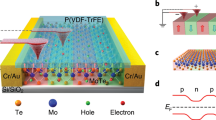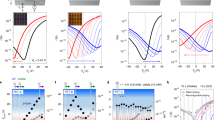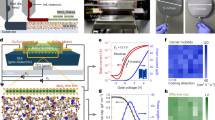Abstract
Two-dimensional (2D) semiconductors are attractive for electronic devices with atomically thin channels. However, controlling the electronic properties of the 2D materials by incorporating impurity dopants is inherently difficult due to the limited physical space in the atomically thin lattices. Here we show that a solid-state ionic doping approach can be used to tailor the carrier type in 2D semiconductors and create programmable devices. Our strategy exploits a superionic phase transition in silver iodide to induce switchable ionic doping. We create few-layer tungsten diselenide (WSe2) devices that can be reversibly transformed into transistors with reconfigurable carrier types and into diodes with switchable polarities by controllably poling the van der Waals integrated silver iodide above the superionic phase transition temperature. We also construct complementary logic gates by integrating and programming identical transistors, and show that the programmed functions can be erased by an external trigger (temperature or ultraviolet irradiation) to create the temporary and delible electronics that are desirable for electronic security.
This is a preview of subscription content, access via your institution
Access options
Access Nature and 54 other Nature Portfolio journals
Get Nature+, our best-value online-access subscription
$29.99 / 30 days
cancel any time
Subscribe to this journal
Receive 12 digital issues and online access to articles
$119.00 per year
only $9.92 per issue
Buy this article
- Purchase on Springer Link
- Instant access to full article PDF
Prices may be subject to local taxes which are calculated during checkout




Similar content being viewed by others
Data availability
The data that support the plots within this paper and other findings of this study are available from the corresponding authors upon reasonable request.
References
Lundstrom, M. Moore’s law forever? Science 299, 210–211 (2003).
Yu, W. J., Kang, B. R., Lee, I. H., Min, Y. S. & Lee, Y. H. Majority carrier type conversion with floating gates in carbon nanotube transistors. Adv. Mater. 21, 4821–4824 (2009).
Huang, X. et al. Sub-50-nm P-channel FinFET. IEEE Trans. Electron Dev. 48, 880–886 (2001).
Liu, H., Neal, A. T. & Ye, P. D. Channel length scaling of MoS2 MOSFETs. ACS Nano 6, 8563–8569 (2012).
Vu, Q. A. et al. A high‐on/off‐ratio floating‐gate memristor array on a flexible substrate via CVD‐grown large‐area 2D layer stacking. Adv. Mater. 29, 1703363 (2017).
Lee, C., Wei, X., Kysar, J. W. & Hone, J. Measurement of the elastic properties and intrinsic strength of monolayer graphene. Science 321, 385–388 (2008).
Li, X. et al. Transfer of large-area graphene films for high-performance transparent conductive electrodes. Nano Lett. 9, 4359–4363 (2009).
Novoselov, K., Mishchenko, A., Carvalho, A. & Neto, A. C. 2D materials and van der Waals heterostructures. Science 353, aac9439 (2016).
Mayer, J. W. Ion implantation in semiconductors. In Proc. 1973 Int. Electron Devices Meeting 3–5 (IEEE, 1973).
Zhang, K. et al. Manganese doping of monolayer MoS2: the substrate is critical. Nano Lett. 15, 6586–6591 (2015).
Chen, C.-H. et al. Hole mobility enhancement and p-doping in monolayer WSe2 by gold decoration. 2D Mater. 1, 034001 (2014).
Bayraktaroglu, B. Transient Electronics Categorization Report AFRL-RY-WP-TR-2017-0169 (US Air Force Research Laboratory, 2017).
Zhou, W. et al. Intrinsic structural defects in monolayer molybdenum disulfide. Nano Lett. 13, 2615–2622 (2013).
Wang, F. et al. Tunable GaTe-MoS2 van der Waals p–n junctions with novel optoelectronic performance. Nano Lett. 15, 7558–7566 (2015).
Cheng, R. et al. Electroluminescence and photocurrent generation from atomically sharp WSe2/MoS2 heterojunction p–n diodes. Nano Lett. 14, 5590–5597 (2014).
Deng, Y. et al. Black phosphorus–monolayer MoS2 van der Waals heterojunction p–n diode. ACS Nano 8, 8292–8299 (2014).
Jeon, P. J. et al. Low power consumption complementary inverters with n-MoS2 and p-WSe2 dichalcogenide nanosheets on glass for logic and light-emitting diode circuits. ACS Appl. Mater. Interfaces 7, 22333–22340 (2015).
Resta, G. V. et al. Doping-free complementary logic gates enabled by two-dimensional polarity-controllable transistors. ACS Nano 12, 7039–7047 (2018).
Baugher, B. W., Churchill, H. O., Yang, Y. & Jarillo-Herrero, P. Optoelectronic devices based on electrically tunable p–n diodes in a monolayer dichalcogenide. Nat. Nanotechnol. 9, 262–267 (2014).
Li, D. et al. Two-dimensional non-volatile programmable p–n junctions. Nat. Nanotechnol. 12, 901–906 (2017).
Pospischil, A., Furchi, M. M. & Mueller, T. Solar-energy conversion and light emission in an atomic monolayer pn diode. Nat. Nanotechnol. 9, 257–261 (2014).
Perera, M. M. et al. Improved carrier mobility in few-layer MoS2 field-effect transistors with ionic-liquid gating. ACS Nano 7, 4449–4458 (2013).
Zhang, Y., Ye, J., Matsuhashi, Y. & Iwasa, Y. Ambipolar MoS2 thin flake transistors. Nano Lett. 12, 1136–1140 (2012).
Zhang, Y., Ye, J., Yomogida, Y., Takenobu, T. & Iwasa, Y. Formation of a stable p–n junction in a liquid-gated MoS2 ambipolar transistor. Nano Lett. 13, 3023–3028 (2013).
Allain, A. & Kis, A. Electron and hole mobilities in single-layer WSe2. ACS Nano 8, 7180–7185 (2014).
Seabaugh, A. et al. Steep subthreshold swing tunnel FETs: GaN/InN/GaN and transition metal dichalcogenide channels. In Proc. 2015 IEEE International Electron Devices Meeting (IEDM) 35.6.1–35.6.4 (IEEE, 2015).
Zhang, Y., Oka, T., Suzuki, R., Ye, J. & Iwasa, Y. Electrically switchable chiral light-emitting transistor. Science 344, 725–728 (2014).
Salamon, M. B. Physics of Superionic Conductors Vol. 15 (Springer Science and Business Media, 2013).
Luryi, S., Xu, J. & Zaslavsky, A. Future Trends in Microelectronics (Wiley, 1999).
Li, L. et al. BEOL compatible graphene/Cu with improved electromigration lifetime for future interconnects. In 2016 IEEE International Electron Devices Meeting (IEDM) 9.5.1–9.5.4 (IEEE, 2016).
Saito, T. et al. High reliability packaging technologies for 175° C continuous operation in IGBT module. In Proc. 2015 Int. Conference on Electronics Packaging and iMAPS All Asia Conference (ICEP-IAAC) 791–794 (IEEE, 2015).
Intel Core Processors Technical Resources (Intel, 2019); https://www.intel.com/content/www/us/en/products/docs/processors/core/core-technical-resources.html
Dutta, A., Sinha, T., Jena, P. & Adak, S. A.c. conductivity and dielectric relaxation in ionically conducting soda–lime–silicate glasses. J. Non-Cryst. Solids 354, 3952–3957 (2008).
Sinitsyn, V., Lips, O., Privalov, A., Fujara, F. & Murin, I. Transport properties of LaF3 fast ionic conductor studied by field gradient NMR and impedance spectroscopy. J. Phys. Chem. Solids 64, 1201–1205 (2003).
Sato, T. et al. Novel solid‐state polymer electrolyte of colloidal crystal decorated with ionic‐liquid polymer brush. Adv. Mater. 23, 4868–4872 (2011).
Wu, C.-L. et al. Gate-induced metal–insulator transition in MoS2 by solid superionic conductor LaF3. Nano Lett. 18, 2387–2392 (2018).
Agrawal, R. & Gupta, R. Superionic solid: composite electrolyte phase—an overview. J. Mater. Sci. 34, 1131–1162 (1999).
Chuang, H.-J. et al. High mobility WSe2 p- and n-type field-effect transistors contacted by highly doped graphene for low-resistance contacts. Nano Lett. 14, 3594–3601 (2014).
Liu, Y. et al. Toward barrier free contact to molybdenum disulfide using graphene electrodes. Nano Lett. 15, 3030–3034 (2015).
Cheng, R. et al. High-frequency self-aligned graphene transistors with transferred gate stacks. Proc. Natl Acad. Sci. USA 109, 11588–11592 (2012).
Cha, J.-H. & Jung, D.-Y. Air-stable transparent silver iodide–copper iodide heterojunction diode. ACS Appl. Mater. Interfaces 9, 43807–43813 (2017).
Wang, J. I.-J. et al. Electronic transport of encapsulated graphene and WSe2 devices fabricated by pick-up of prepatterned hBN. Nano Lett. 15, 1898–1903 (2015).
Dean, C. R. et al. Boron nitride substrates for high-quality graphene electronics. Nat. Nanotechnol. 5, 722–726 (2010).
Liu, Y. et al. Approaching the Schottky-Mott limit in van der Waals metal-semiconductor junctions. Nature 557, 696–700 (2018).
Kharkats, Y. I. Fast ion transport in solids induced by an electric field. Solid State Ionics 2, 301–308 (1981).
Shockley, W. Electrons and Holes in Semiconductors: with Applications to Transistor Electronics (van Nostrand, 1950).
Sze, S. M. & Ng, K. K. Physics of Semiconductor Devices (Wiley, 2006).
Reynolds, S., Hume, W. M., Vonnegut, B. & Schaefer, V. J. Effect of sunlight on the action of silver iodide particles as sublimation nuclei. Bull. Am. Meteorol. Soc. 32, 47–47 (1951).
Debye, P. & Huckel, E. Phys. Z. 24, 185–305 (1923).
Stegmaier, S., Voss, J., Reuter, K. & Luntz, A. C. Li+ defects in a solid-state Li ion battery: theoretical insights with a Li3OCl electrolyte. Chem. Mater. 29, 4330–4340 (2017).
Kvist, A. & Tärneberg, R. Self-diffusion of silver ions in the cubic high temperature modification of silver iodide. Z. Naturforsch. A 25, 257–259 (1970).
Samsung Completes Development of 5-nm EUV Process Technology (Anandtech, 2019); https://www.anandtech.com/show/14231/samsung-completes-development-of-5-nm-euv-process-technology
Fuller, E. J. et al. Parallel programming of an ionic floating-gate memory array for scalable neuromorphic computing. Science 364, 570–574 (2019).
Acknowledgements
X.D. acknowledges support from the Office of Naval Research through award no. N00014-18-1-2707. Y.H. acknowledges financial support from the Office of Naval Research through award no. N00014-18-1-2491. B.D. acknowledges support from the Office of Naval Research through award no. N00014-16-1-2164. I.S. acknowledges support from the International Scientific Partnership Program at King Saud University (ISPP-148). Y.Z. acknowledges support from the National Key Research and Development Program of China through grant no. 2018YFA0703503. We acknowledge the Electron Imaging Centre at UCLA for TEM technical support and the Nanoelectronics Research Facility at UCLA for device fabrication technical support. We thank H.-C. Cheng, Y.-C. Huang, H. Wu, C. Wang, C. Choi, Z. Zhao, Z. Huang, G. Zhong, P. Wang and J.-W. Lee for their help in the laboratory.
Author information
Authors and Affiliations
Contributions
X.D. and Y.H. designed and supervised the research. S.-J.L. conducted most of the experiments and analysed the data. J.H. conducted the XRD and TEM experiments, and C.S.C. and B.D. conducted the AgI ionic conductivity measurements. Z.L., P.C., Y.L., J.G., C.J., Y.W., L.W., Q.L., I.S., X.D.D. and Y.Z. contributed materials, material characterizations, device fabrications or data analysis. X.D. and S.-J.L. wrote the manuscript with input from all co-authors. All authors reviewed and commented on the manuscript.
Corresponding authors
Ethics declarations
Competing interests
The authors declare no competing interests.
Additional information
Publisher’s note Springer Nature remains neutral with regard to jurisdictional claims in published maps and institutional affiliations.
Supplementary information
Supplementary Information
Supplementary Notes 1 and 2, Figs. 1–14 and Tables 1 and 2.
Rights and permissions
About this article
Cite this article
Lee, SJ., Lin, Z., Huang, J. et al. Programmable devices based on reversible solid-state doping of two-dimensional semiconductors with superionic silver iodide. Nat Electron 3, 630–637 (2020). https://doi.org/10.1038/s41928-020-00472-x
Received:
Accepted:
Published:
Issue Date:
DOI: https://doi.org/10.1038/s41928-020-00472-x
This article is cited by
-
Reconfigurable logic and in-sensor encryption operations in an asymmetrically tunable van der Waals heterostructure
Nano Research (2024)
-
Lead halide perovskite sensitized WSe2 photodiodes with ultrahigh open circuit voltages
eLight (2023)
-
Contact-engineered reconfigurable two-dimensional Schottky junction field-effect transistor with low leakage currents
Nature Communications (2023)
-
Ionotronic WS2 memtransistors for 6-bit storage and neuromorphic adaptation at high temperature
npj 2D Materials and Applications (2023)
-
Perovskite sensitized 2D photodiodes
Light: Science & Applications (2023)



